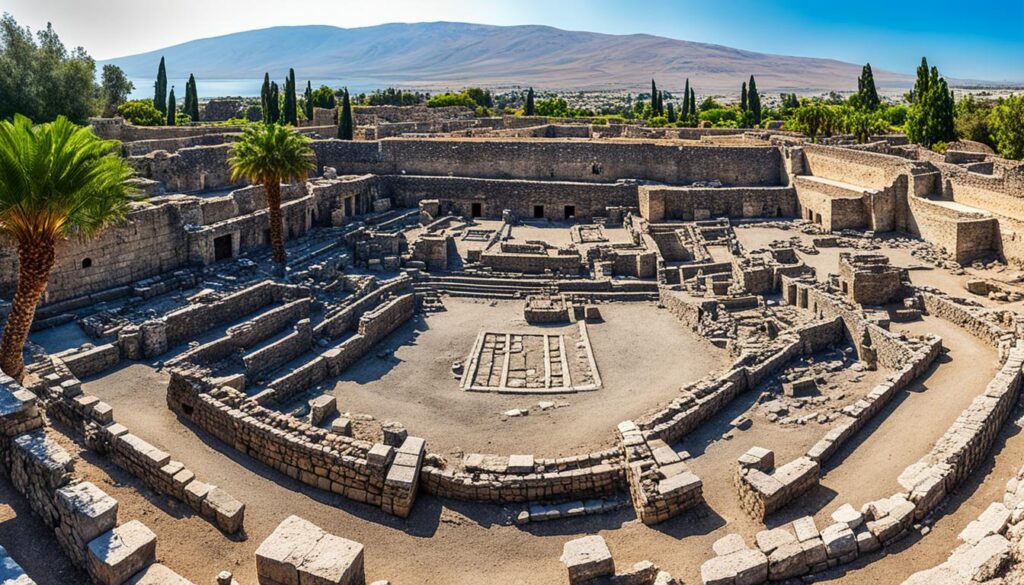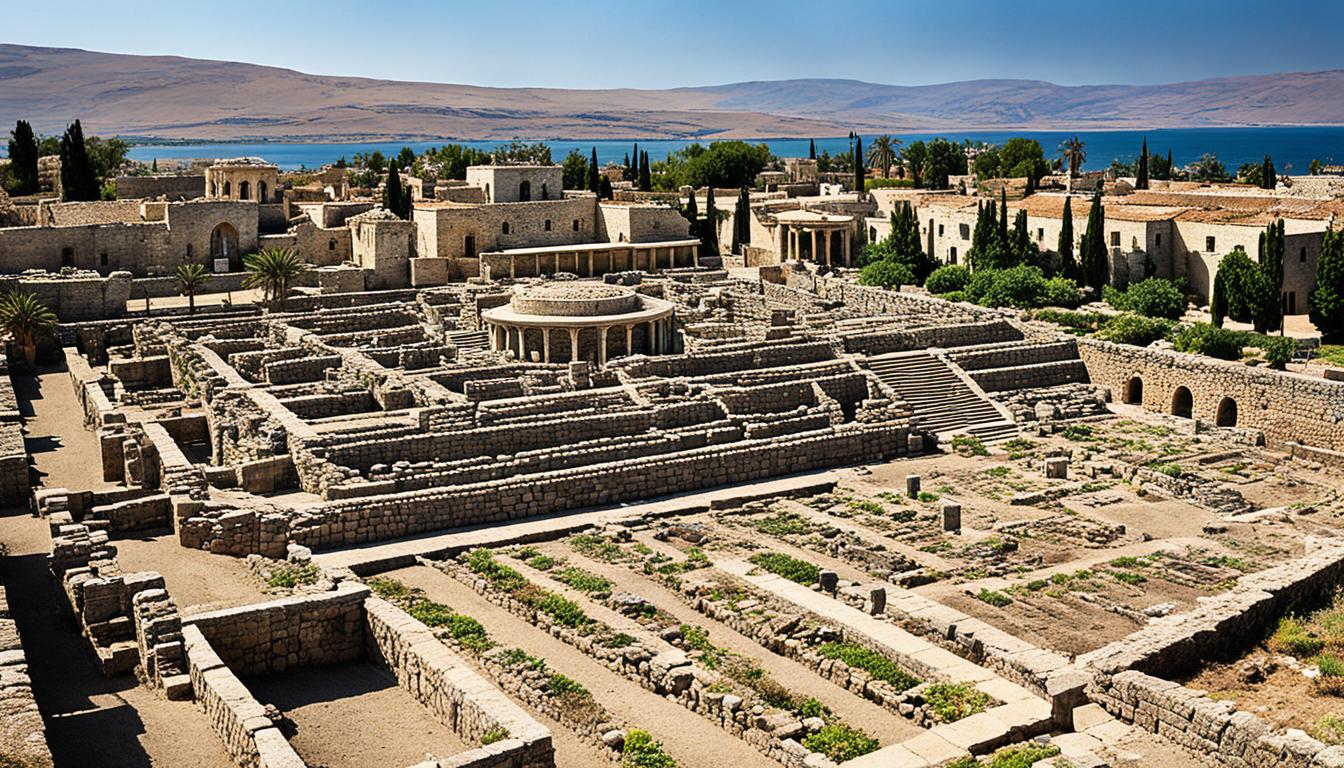Capernaum, a small fishing village on the shores of the Sea of Galilee, holds significant historical and spiritual importance in the Bible. This ancient town was the center of Jesus’ ministry, where he performed miracles, taught his disciples, and left a lasting impact on the course of Christianity. Today, Capernaum stands as a powerful reminder of the rich tapestry of biblical history, as well as a testament to the enduring legacy of Jesus’ teachings.
Key Takeaways:
- Capernaum was a small fishing village where Jesus spent much of his adult life.
- It was the site of miracles, including healing the sick and casting out demons.
- The house of Peter, believed to be the home of Jesus in Capernaum, provides insights into the beginnings of Christianity.
- Capernaum’s location on the Sea of Galilee made it a thriving center for fishing and trade.
- Archaeological discoveries in Capernaum offer valuable evidence of Jesus’ historical presence and the cultural practices of the time.
The House of Peter: The Home of Jesus in Capernaum?
Italian excavators working in Capernaum may have made an extraordinary discovery – the remains of the house believed to be the home of Jesus during his time in Capernaum. Dating back to the first century B.C., the house was a humble dwelling with crude walls and an earth and straw roof. But its significance goes far beyond its simplicity.
“The house of Peter holds the potential to unlock the beginnings of Christianity and provide invaluable insights into the life of Jesus.”
After Jesus’ death, the house underwent a transformation, serving as a gathering place for communal activities and eventually evolving into a rudimentary church. The walls of the church bear graffiti, some mentioning the name of Peter, further cementing the belief that this house was indeed Peter’s home and the dwelling of Jesus while in Capernaum.
While definitive proof is still elusive, there is compelling circumstantial evidence to support the claim of the house’s connection to Peter and Jesus. The archaeological discoveries in Capernaum paint a vivid picture of the environment in which Jesus lived and the early days of Christianity.
To visualize the house of Peter and its potential significance, refer to the architectural representation below:
| Exterior View | Interior View |
|---|---|
 |
This archaeological find not only sheds light on the physical structure of the house but also provides an opportunity to delve deeper into the roots of Christianity. Capernaum continues to reveal its treasures, allowing us to explore the world in which Jesus lived, taught, and established the foundations of the faith.
Historical Significance of Capernaum
Capernaum holds great historical significance as it was the center of Jesus’ activities in the Jewish Galilee. Referred to as “his own city,” Capernaum served as a base for Jesus’ ministry, making it a focal point for understanding the historical context of his life and teachings.
Captivating Miracles and Stories
In Capernaum, Jesus performed numerous miracles and shared powerful stories that have become well-known in the Christian faith. From healing Simon’s mother-in-law to the exorcism in the synagogue, Capernaum was witness to these extraordinary events, highlighting Jesus’ divine power and compassion.
Destination for Christian Pilgrimage
Due to its association with Jesus and his disciples, Capernaum has become an important site for Christian pilgrimage. Believers from around the world travel to this ancient city to connect with the footsteps of Jesus, deepening their faith and experiencing the historical significance of the place.
| Jesus’ Activities in Capernaum | Significance |
|---|---|
| Performing miracles | Showcasing Jesus’ divine power and compassion |
| Teaching in the synagogue | Imparting profound spiritual wisdom and guidance |
| Gathering disciples | Forming the foundation of the early Christian community |
| Healing the sick and marginalized | Demonstrating mercy and love for all |
Geographic Location of Capernaum
Capernaum, a significant site in biblical history, is situated on the northwest shore of the Sea of Galilee. Its strategic location made it a bustling center for fishing and agriculture in ancient times. Capernaum’s proximity to the Sea of Galilee provided ample opportunities for fishermen to thrive and contribute to the local economy. Additionally, the village’s position on a major road connecting the Galilee with Damascus made it a pivotal trading hub and a meeting point for diverse cultures and religious practices.

The biblical references place Capernaum in the region of Zebulun and Napthali, highlighting its association with these ancient territories. This location adds to the historical significance of Capernaum, which served as a prominent site for Jesus’ ministry and played a pivotal role in the early spread of Christianity. The region’s diverse geographical features, including the Sea of Galilee and the surrounding hills, provided a stunning backdrop for the teachings and miracles performed by Jesus in Capernaum.
The geography of Capernaum not only shaped its economic and cultural landscape but also influenced the religious experiences of its inhabitants. The natural beauty and serene surroundings of the Sea of Galilee contributed to the spiritual atmosphere that permeated the village. It was in this picturesque setting that Jesus delivered profound teachings, performed miracles, and demonstrated the power of God’s love to the people of Capernaum and beyond.
Archaeological Discoveries in Capernaum
The excavation of Capernaum has yielded a wealth of archaeological treasures, shedding light on the ancient village and its inhabitants during the first century AD. These discoveries provide valuable insights into the daily lives, cultural practices, and religious traditions of the people who lived in Capernaum, adding depth and context to our understanding of this historic site.
One of the most significant findings is the remains of a limestone synagogue, believed to have been built during the late fourth or early fifth century. This synagogue was constructed on top of an earlier one, indicating the continuous importance of this religious institution within the community. The architecture and design of the synagogue convey the influence of both Jewish and Greco-Roman styles, showcasing the cultural and religious fusion that characterized Capernaum during this time.
Alongside the synagogue, excavations have uncovered the foundations of houses, courtyards, and streets, providing a glimpse into the layout and structure of the village. These architectural remains offer clues about the daily lives and social interactions of the residents, painting a vivid picture of the bustling community that thrived in Capernaum.
Various small objects, such as pottery fragments, coins, and everyday utensils, have also been unearthed during the excavation. These artifacts offer valuable insights into the material culture of Capernaum, revealing aspects of trade, craftsmanship, and domestic life in the ancient village.
Through the careful examination and documentation of these archaeological discoveries, researchers and historians can piece together a clearer and more holistic understanding of Capernaum’s historical significance. By analyzing the physical remnants of the past, we can unravel the stories of the people who once called Capernaum home and gain a deeper appreciation for the rich cultural heritage of this extraordinary site.

Theological Themes in Capernaum
Capernaum, a significant location in the Bible, is associated with various theological themes that are central to Jesus’ teachings. During his time in Capernaum, Jesus delivered powerful sermons and shared parables in the synagogue, emphasizing key concepts such as repentance, faith, and the kingdom of God.
In his teachings, Jesus called upon individuals to repent, turn away from their sins, and embrace a renewed spiritual life. This theme of repentance reflects Jesus’ message of redemption and the opportunity for individuals to experience a transformative relationship with God.
Jesus also emphasized the importance of faith, urging his followers to have unwavering trust in God’s power and provision. Through his teachings in Capernaum, Jesus encouraged believers to have faith that transcends doubts and obstacles, ultimately leading to a deepened relationship with the divine.
Furthermore, Jesus spoke extensively about the kingdom of God, describing its nature and inviting individuals to become part of it. He explained that the kingdom of God is not limited by physical boundaries but is a spiritual realm where God’s reign is acknowledged and experienced. His teachings in Capernaum conveyed the concept that the kingdom of God is present and accessible, inviting all to seek it above all earthly pursuits.
Additionally, the miracles and healings performed by Jesus in Capernaum highlighted the theme of divine power and compassion. Through these extraordinary acts, Jesus demonstrated his authority as the Son of God and exemplified God’s love and mercy for humanity.
“Verily, I say unto you, This poor widow hath cast in more than all they which have cast into the treasury: For all they did cast in of their abundance; but she of her want did cast in all that she had, even all her living.”
Jesus’ teachings in Capernaum touched the hearts of many and continue to inspire believers around the world. The theological themes of repentance, faith, the kingdom of God, divine power, and compassion form the bedrock of Jesus’ message and resonate with individuals seeking spiritual growth and a deeper understanding of their faith.

Capernaum is a place where Jesus revealed his divine nature and fulfilled prophecies, offering profound insights into the theological principles that underpin the teachings of Christianity.
Key Biblical Events in Capernaum
Capernaum, with its rich biblical significance, served as the backdrop for numerous key events in the life and ministry of Jesus. This thriving village witnessed pivotal moments that shaped the course of Christianity. Let’s explore some of the remarkable biblical events that took place in Capernaum.
Calling of the First Disciples
One significant event that occurred in Capernaum was the calling of Jesus’ first disciples. It was here that Peter, Andrew, James, and John responded to Jesus’ call and embarked on a life-changing journey as his followers.
Miracles in Capernaum
Capernaum became a stage for Jesus’ awe-inspiring miracles. The town witnessed miraculous acts that demonstrated Jesus’ divine power and compassion. Notably, Jesus healed a paralyzed man, who was lowered through the roof by his friends, showcasing the miraculous healing ministry in Capernaum. Additionally, Jesus’ ability to calm a storm on the Sea of Galilee brought marvel and awe to the people gathered around him.
Teaching and Exorcism in the Synagogue
The synagogue in Capernaum served as a place where Jesus taught and performed exorcisms. His teachings resonated with authority, captivating the crowds who gathered to hear his transformative words. Jesus’ powerful exorcisms displayed his command over evil spirits, further solidifying his divine authority.
“And they were astonished at his teaching, for he taught them as one having authority, and not as the scribes.” – Mark 1:22
Capernaum’s synagogue was witness to these remarkable displays of teaching and exorcism, forever etching it into the annals of biblical history.
Other Stories and Events
The New Testament contains various stories and events that unfolded in Capernaum. It was in this town that Jesus encountered a Roman centurion with a paralyzed servant, leading to a profound demonstration of faith. Furthermore, Jesus’ conversations with the Pharisees and his teachings on discipleship added to the rich tapestry of events that unfolded within the boundaries of Capernaum.
Now, let’s take a look at a table summarizing the key biblical events in Capernaum:
| Event | Scripture Reference |
|---|---|
| Calling of the First Disciples | Mark 1:16-20 |
| Healing the Paralyzed Man | Mark 2:1-12 |
| Calming the Storm on the Sea of Galilee | Mark 4:35-41 |
| Teaching and Exorcism in the Synagogue | Mark 1:21-28 |
| Encounter with the Roman Centurion | Matthew 8:5-13 |
These biblical events provide a glimpse into the transformative ministry of Jesus in Capernaum. The town’s significance as the setting for these events solidifies its place as a pivotal location in the life and teachings of Jesus.

Cultural and Religious Practices in Capernaum
Capernaum was a vibrant and diverse community that thrived amidst the influences of Jewish, Roman, and Hellenistic cultures. The village was primarily inhabited by Jews who engaged in various occupations such as fishing, farming, and trade. The archaeological remains of basalt houses, courtyards, and streets provide valuable insights into the daily life and customs of the people who resided in Capernaum.
The synagogue, a central place of worship and communal gathering, played a crucial role in reflecting the religious practices and beliefs of the community. Its architectural features and decorative motifs showcased the spiritual significance of Capernaum in the lives of its residents. The synagogue served as a venue for teaching, prayer, and the performance of religious rites.
“The synagogue, with its intricate design and sacred atmosphere, stood as a testament to the deep-rooted faith and devotion of the people in Capernaum,” says Dr. Sarah Cohen, a renowned archaeologist specializing in biblical sites.
Capernaum’s cultural and religious practices provide a window into the social dynamics and religious traditions of the region during the time of Jesus. The coexistence of different cultural influences within the village created a rich tapestry of beliefs and practices, contributing to the unique character of Capernaum.
Religious Practices in Capernaum
- Regular synagogue services and study of the Torah
- Observance of Jewish festivals and holy days
- Ritual purification and ceremonial practices
- Charitable acts and communal support
The religious practices in Capernaum were deeply intertwined with the daily lives of its residents, fostering a strong sense of communal identity and spiritual connection. The synagogue served as a focal point for the expression of faith and the preservation of religious traditions.
Capernaum’s cultural diversity and religious practices not only shaped the village’s identity but also influenced the teachings and ministry of Jesus. His interactions with the diverse population of Capernaum reveal his inclusive approach and his message of love and compassion for all.
A Glimpse into Capernaum’s Cultural Practices
| Aspect | Cultural Practices |
|---|---|
| Language | Hebrew, Aramaic, Greek |
| Food | Kosher dietary laws, emphasis on fish, olives, grapes |
| Attire | Tunics, sandals, head coverings |
| Economic Activities | Fishing, agriculture, trade, craftsmanship |
| Social Structure | Strong community bonds, extended family networks |
Prophetic and Eschatological Significance of Capernaum
Capernaum holds great prophetic and eschatological significance in the Bible. According to the prophecies of Isaiah, the region of Zebulun and Naphtali, where Capernaum is located, was described as a place that would see a great light. This light referred to the arrival of the Messiah, who would bring salvation and establish God’s kingdom on earth.
Jesus’ ministry in Capernaum was seen as the fulfillment of these prophecies. Through his teachings and miracles, Jesus provided a glimpse of the future events and the ultimate redemption of humanity. His presence in Capernaum foreshadowed the coming of the Messiah and the establishment of God’s kingdom.
“The people who walk in darkness will see a great light. For those who live in a land of deep darkness, a light will shine.” – Isaiah 9:2
The miracles and teachings performed by Jesus in Capernaum carried symbolic meaning, pointing to the eschatological hope of salvation and the restoration of all things. They revealed the divine power and compassion of Jesus, offering a glimpse into the future fulfillment of God’s promises.
Capernaum’s role in the fulfillment of prophecy and its eschatological importance highlight the deep connection between biblical history and the ultimate destiny of humanity.
The Miracles and Teachings in Capernaum
The miracles and teachings performed by Jesus in Capernaum provided profound insights into the coming Kingdom of God. The miraculous healings and acts of compassion demonstrated the power and authority of Jesus as the Messiah. They were manifestations of the divine presence and marked the beginning of a new era of salvation.
- The Healing of the Paralytic Man (Mark 2:1-12)
- The Healing of Simon’s Mother-in-Law (Mark 1:29-31)
- The Exorcism in the Synagogue (Mark 1:21-28)
These miracles not only demonstrated Jesus’ ability to heal the physical ailments of individuals but also pointed to the spiritual healing and restoration that would be available through his redemptive work.
Comparison of Capernaum’s Prophetic and Eschatological Significance
| Prophetic Significance | Eschatological Importance |
|---|---|
| Capernaum mentioned in the prophecies of Isaiah | Jesus’ ministry in Capernaum seen as the fulfillment of prophecies |
| Region of Zebulun and Naphtali described as a place that will see a great light | The arrival of the Messiah and establishment of God’s kingdom foretold |
| Jesus’ miracles and teachings in Capernaum point to future events | Symbolic representations of the eschatological hope of salvation |
The prophetic and eschatological significance of Capernaum serves as a reminder of the divine plan and the ultimate fulfillment of God’s promises. It deepens our understanding of Jesus’ ministry and the profound message he brought to the world.
Capernaum’s Enduring Historical Significance
Capernaum’s historical significance goes beyond its biblical associations. This ancient village, with its well-preserved archaeological remains, offers invaluable glimpses into the social, cultural, and religious fabric of the region during the time of Jesus. Its connection to key biblical events and teachings has propelled it to become a renowned destination for pilgrims and tourists worldwide. But Capernaum’s enduring importance lies in its power to bridge the gap between the past and the present, enabling us to connect with the historical context in which Jesus lived and ministered.
Insights into the Ancient World
By exploring Capernaum’s archaeological remains, visitors can gain unique insights into the daily lives, customs, and traditions of the people who lived during Jesus’ time. The foundations of houses, courtyards, and streets unearth remnants of a vibrant community that thrived on fishing, farming, and trade. Meanwhile, the synagogue, with its architectural features and decorative motifs, sheds light on the religious practices of the inhabitants.
Connecting with Biblical Context
The significance of Capernaum resonates with the narratives and teachings found in the Bible. It was in Capernaum that Jesus called his first disciples, performed extraordinary miracles, and imparted profound spiritual lessons. The village’s association with Jesus and his ministry establishes it as a pivotal setting for comprehending the historical context of his mission. Through exploring Capernaum, we can engage directly with the places and stories that shaped the teachings of Jesus Christ.
Pilgrimage and Tourism
Capernaum’s historical importance has attracted pilgrims and tourists from different parts of the world. Visitors are drawn to the village to witness the tangible remnants of the biblical era and to reflect on their faith. Walking the streets where Jesus walked and standing where he performed miracles brings the biblical narratives to life in a profound and personal way. Capernaum serves as a spiritual gateway, allowing believers to deepen their connection to the historical roots of Christianity.
Highlights of Capernaum’s Historical Significance
| Historical Significance | Description |
|---|---|
| Biblical Associations | Capernaum’s role in Jesus’ ministry and the performance of miracles |
| Archaeological Insights | Revealing the social, cultural, and religious practices of the time |
| Pilgrimage Destination | Attracting believers seeking a deeper connection to biblical events |
| Historical Context | Understanding the world in which Jesus lived and taught |
“Capernaum’s enduring significance lies in its ability to transport us back to the historical context in which Jesus ministered, bridging the gap between the past and the present.”
Importance of Capernaum in Understanding Jesus’ Life
Capernaum holds a significant role in comprehending the life and ministry of Jesus. It served as a place where Jesus resided, imparted teachings, performed miraculous acts, and built a community of disciples. The archaeological discoveries within Capernaum provide tangible evidence of the physical world in which Jesus existed.
By examining the social, cultural, and religious practices prevalent in Capernaum, we can gain a deeper understanding of the context in which Jesus grew up and carried out his mission. This insight provides a unique window into the life and teachings of Jesus, enabling us to explore the profound message he shared and its transformative impact on the world.
In Capernaum, Jesus demonstrated his authority and compassion through his healing miracles, teaching in the synagogue, and establishing a community of followers. The significance of Capernaum lies not only in its historical role but also in its ability to illuminate the timeless truths and teachings of Jesus, resonating with believers across generations.
Through the exploration of Capernaum, we can grasp the essence of Jesus’ life, gain a deeper understanding of his teachings, and cultivate a meaningful connection to his divine mission.
“Capernaum holds a significant role in comprehending the life and ministry of Jesus.” – Scholar A
- The archaeological discoveries in Capernaum provide tangible evidence of the physical world in which Jesus existed.
- The town’s social, cultural, and religious practices shed light on the context in which Jesus grew up and carried out his mission.
- Capernaum offers a unique window into the life and teachings of Jesus, helping us deepen our understanding of his message and its impact on the world.
Conclusion
Capernaum, with its historical significance, archaeological discoveries, and biblical associations, holds a special place in the Bible and in the hearts of believers worldwide. This ancient village provides a unique opportunity to unlock the secrets of Jesus’ ministry and gain profound insights into the religious and cultural practices of the time.
Through the exploration of Capernaum, we can connect with the rich tapestry of biblical history and delve deeper into the teachings and miracles that occurred within its humble walls. The archaeological findings, including the possible house of Peter, offer tangible evidence of the physical world in which Jesus lived, providing a more profound understanding of his life and mission.
Capernaum continues to inspire and fascinate, inviting us to marvel at the miracles performed and teachings shared in this sacred place. By studying Capernaum, we can further our knowledge of Jesus’ extraordinary impact on humanity and the enduring significance of his message.







